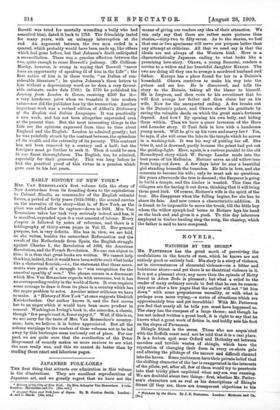JAPANESE FOLK-LORE.t Tax first thing that attracts our admiration in
this volume is the illustrations. They are excellent reproductions of Japanese art, and we greatly regret that we have not the
• History of ths City of New York. By Mrs. Schuyler Van Rensselaer. 2 vols. London Macmillan and Co. [218. net.] t Ancient Tales and Polk.Lor• of Japan. By B. Gordon Smith. London : A. atid C. Black. [20a. net.] means of giving our readers any idea of their attraction. We can only say that there are rather more pictures than stories,—sixty-two to fifty-seven. As to the stories, we feel that one or two specimens will serve our purpose better than any attempt at criticism. All that we need say is that the ideals are not always of the Western kind. Here is a chpracteristically Japanese ending to what looks like a promising love-story. Okawa, a young Samurai, renders a service to a widow and her beautiful daughter Kazuye. The two are doing all they can to avenge a murdered husband and father. Kazuye has a place found for her in a Daimio's household. Okawa contrives to make his way into the palace and see her. He is discovered, and tells the story to the Daimio, taking all the blame to himself. He is forgiven, and then vows to his sweetheart that he will first avenge her father and then claim her as his wife. Now for the unexpected ending. A fire breaks out in the Daimio's palace, and Okawa shows his gratitude by saving the valuable deeds on which the great man's fortunes depend. And how P By opening his own belly, and hiding them within. Then we have a queer inversion of the Hero and Leander story. 0 Tani falls in love with a handsome young monk. Will he give up his vows and marry her ? Yes, he says, if she will cross the lake to the temple which be serves in a washing-tub. It was his way of putting her off. She tries it, and is drowned, partly because the priest had put out the guiding-light. Here, again, is a curious parallel to the old Hama dryad story which W. Savage Landor made into the best poem of his liellenies. Heitaro saves an old willow-tree from being cut down. A few days later be sees a beautiful girl standing beneath the branches. He falls in love, and she consents to become his wife ; only he must ask no questions. Six years afterwards the tree is doomed ; the Emperor is going to build a temple, and the timber is wanted. This time the villagers are for having it cut down, thinking that it will bring them good luck. Of course, Heitaro's wife is the spirit of the tree. She disappears when the felling begins, for she has to share its fate. And now comes a characteristic addition. It is found to be impossible to move the trunk, till the little boy whom the willow nymph had borne to Heitaro lays his hand on the back end and gives it a push. To this day labourers employed in timber-hauling sing the song, the chantey, which the father is said to have composed.






































 Previous page
Previous page